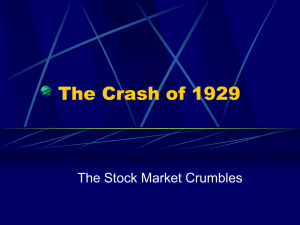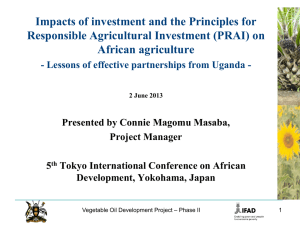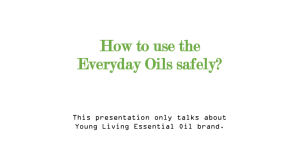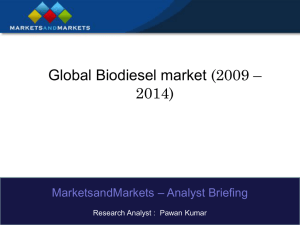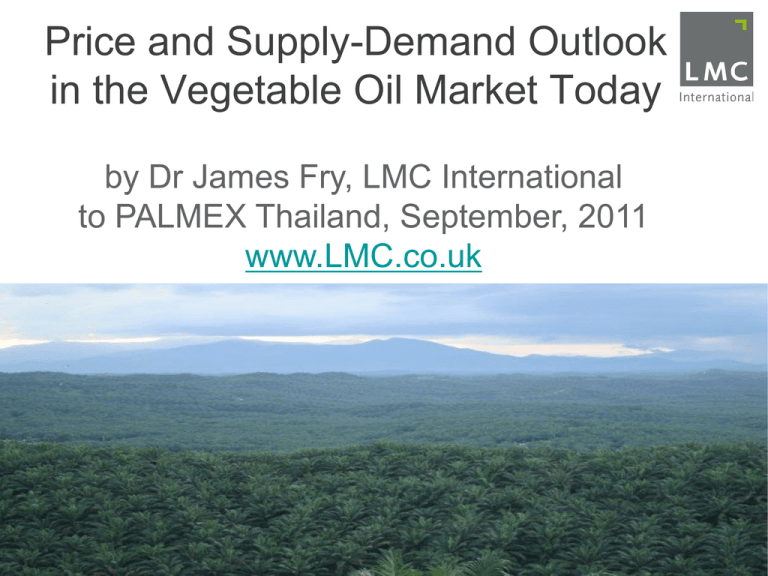
Price and Supply-Demand Outlook
in the Vegetable Oil Market Today
by Dr James Fry, LMC International
to PALMEX Thailand, September, 2011
www.LMC.co.uk
Outline of my presentation today
• I will start by describing one of the most surprising
changes in the behaviour of the world vegetable oil
market, which has occurred within the past five years.
• This is the way in which vegetable oils have become
part of the petroleum complex, as regards pricing. I will
explain why and how this has happened.
• This has far-reaching consequences for the future
behaviour of vegetable oil prices. In particular, while
supply-demand balances do matter, they are less
important than they used to be in setting oils prices.
• Palm oil stocks are still the main driver of price
differentials within the oils complex, and so I will
examine the recent trends in global palm oil output.
The revolution in vegetable oil price
behaviour
Before 2007 there was no link evident between
petroleum and vegetable oil prices. CPO was
often cheaper than crude oil per tonne.
900
EU Prices, US$ per tonne
800
700
600
500
400
300
Palm oil was actually less
expensive than crude oil
200
100
0
Jan-03
Jan-04
Brent Crude
Jan-05
Palm Oil
Jan-06
Soy Oil
Rapeseed Oil
Jan-07
Since 2007, a price band has appeared, linking
vegetable oil prices to crude oil prices, within a
price band with vegetable oils at a premium.
1,600
EU Prices, US$ per tonne
1,400
1,200
1,000
800
600
400
200
0
Jan-07
Jan-08
Brent Crude
Jan-09
Palm Oil
Jan-10
Soy Oil
Jan-11
Rapeseed Oil
The two lauric oils are not so strongly tied to the
new price band, but their premium over crude
petroleum has shrunk sharply in recent weeks.
2,400
EU Prices, US$ per tonne
2,000
1,600
1,200
800
400
0
Jan-07
Jan-08
Brent Crude
Jan-09
Palm Oil
Jan-10
PKO
Jan-11
CNO
Examining differentials vs. diesel for oils, we can
see that, after a sharp correction after January,
the CPO premium has settled near its average.
Premium over diesel, US$ per tonne
600
500
400
300
200
100
0
-100
-200
Jan-07
CPO
Jan-08
SBO
Jan-09
Jan-10
CPO Average
Jan-11
SBO Average
The emergence of a price band is the
major revolution in vegetable oil pricing
• We can now see very clearly that there is a price band
in place, which became established in 2007.
• When vegetable oil prices get too far above crude oil,
a correction occurs, and typically quite fast. We saw
such a correction in 2008 and again this year.
• Since the floor of the band is set by crude oil prices, it
seems likely that biofuels are the key to the link.
• This view is reinforced by the evidence that lauric oils,
which are distinct from the other oils and are not used
in biofuels, are less closely tied to the new price band.
• However, I suppose the link could be caused by basic
commodity speculation, and so I now turn to examine
whether there is a good reason for the band to exist.
Biodiesel demand has changed the
balance within the oil and meal sectors
300
150
250
125
200
100
150
75
100
50
50
25
0
0
1972 1975 1978 1981 1984 1987 1990 1993 1996 1999 2002 2005 2008
Meals, Soymeal Equivalent
Oils
Oil (Million Tonnes)
Meal in Soymeal Equivalent (million tonnes)
Biofuels have pulled demand growth rates for
oil ahead of those for protein meal. This boosts
the reliance upon high oil-content crops.
Until ten years ago, the growth rates in the
demand for oils and meals were similar
• If we look back 40 years, we see that, by coincidence,
global demand for oils and meals grew in step with
one another.
• The feedback from income growth to oil demand (for
food) and meal demand (for meat) meant that the
global consumption of oils and meals rose in parallel.
• Since 2000, world vegetable oil demand has grown
faster than meal demand, with the divergence
between the two curves widening steadily.
• The best reason for the change has to be biofuels.
They generate a demand for oils, but without any
corresponding demand for protein meal.
Among oil-bearing crops, oil palm’s oil yield/ha.
averages five times that of rapeseed, six times
that of sunflower and seven times soybean’s.
4.0
Oil yield, tonnes per hectare
3.5
3.0
2.5
2.0
1.5
1.0
0.5
0.0
Oil Palm
Rapeseed
Sunflower
Soybean
In contrast, oil palm has by far the lowest meal
content of leading oilseeds. Hence, oil palm is
the oil crop best placed for the new biofuel era.
90%
Meal content of crop output
80%
70%
60%
50%
40%
30%
20%
10%
0%
Oil Palm
Rapeseed
Sunflower
Soybean
Palm oil has captured market share thanks to
rapid output growth. It has overtaken soybean
oil to become the world’s most important oil.
50
Million Tonnes
40
30
Average Annual Growth 1975-2011:
Palm Oil = 8.3%
Palm Kernel Oil = 7.7%
Rapeseed Oil = 6.2%
Soybean Oil = 4.8%
Sunflower Oil = 2.8%
20
10
0
1975 1978 1981 1984 1987 1990 1993 1996 1999 2002 2005 2008 2011
Palm Oil
Palm Kernel Oil
Rapeseed Oil
Soybean Oil
Sunflower Oil
The new global balance of consumption
growth plays to oil palm’s strengths
• Now that we are in a world that craves more and
more vegetable oil, and is doing so at a faster rate
than its demand for meal, it wants more of the world
oilseed output to come from a crop that gives us a lot
of oil and relatively little meal.
• The crop that best meets this need is called “oil
palm”!
• As a result, it is not simply because oil palm is a
highly productive and cost-competitive crop that it
has captured a greater share of world supply.
• In reality, the world needs more palm oil, rather than
other oils, if it is to avoid the problems of large
surpluses of unwanted oilseed meal to dispose of.
Biodiesel demand is very sensitive to
the biodiesel premium over diesel
500
300
460
250
420
200
380
150
340
100
300
50
260
0
220
-50
180
Jan-07
Jan-08
US + German Demand
-100
Jan-09
Jan-10
Jan-11
Average US & German Biodiesel Premium
Premium, US$ per tonne
Monthly Biodiesel Demand, '000 tonnes
Biodiesel use in Germany and the US, reacts
quickly to swings in the biodiesel premium over
diesel. This links biodiesel to diesel prices.
100
550
90
450
80
350
70
250
60
150
50
50
40
-50
Apr-09 Jul-09 Oct-09 Jan-10 Apr-10 Jul-10 Oct-10 Jan-11 Apr-11 Jul-11
Demand
Biodiesel Premium
Biodiesel Premium over Diesel (US$/tonne)
UK Demand ('000 tonnes)
The same is true of biodiesel demand in the UK
where biofuel users can pay the government
money not to use biofuels if they get too costly.
Biodiesel demand has been affected by
high price differentials earlier this year.
• Around the world, biodiesel users cut back demand
when biodiesel became very expensive vs. diesel.
• Some of the cutbacks were temporary, as blenders
waited until biodiesel became cheaper. Some were
caused by users “buying out” their mandates
• In a few cases, governments responded to high food
prices by reducing their legal mandate targets.
• In Thailand, your government reacted to low palm oil
output by cutting the mandate for a while.
• The effect of all these changes was to pull biodiesel
prices (and hence vegetable oil prices) closer to the
price of diesel, narrowing the spread in the market.
Understanding vegetable oil prices
The main factors behind vegetable oil
price levels today now include biofuels
1.
I hope that I have persuaded you that you have to
take account of biofuels today. In English, we talk
about a “tail wagging the dog”. In oils today, the “tail”
of biofuels, with only one eighth of world oil demand’
is waging the “dog” of the global vegetable oil
market (with the other seven eighths of demand).
2.
Because of the price band, petroleum prices are
undoubtedly a major factor behind oils pricing today.
3.
Vegetable oil stocks also influence prices. The
recent period of low palm oil output has passed, and
I will next study how the upturn is affecting stocks.
4.
Finally, vegetable oils compete. I will illustrate this
with evidence from price-sensitive Indian imports.
Stocks and oil supply-demand balances
Strong palm oil output this year will be crucial
in lifting growth in output of the main vegetable
oils to 6 million tonnes worldwide in 2011/12.
Oil Output Growth, million tonnes
8
7
6
5
4
3
2
1
0
-1
-2
2006/07-2007/08 2007/08-2008/09 2008/09-2009/10 2009/10-2010/11 2010/11-2011/12
Soybeans Rapeseed Sunflower Palm Sum
Oil Output and Demand Growth, million tonnes
High prices will slow 2011/12 world demand
growth and cause it to lag behind output growth,
after two years when demand exceeded output.
9
8
7
6
5
4
3
2
1
0
2006/072007/08
2007/082008/09
2008/092009/10
Demand
Output
2009/102010/11
2010/112011/12
Oil output will be sustained in 2011 by cutting
oilseed stocks. Biofuel price sensitivity will be
crucial to balancing world oil supply vs. demand.
Oil Output Growth, million tonnes
12
10
8
6
4
2
0
2006/072007/08
2007/082008/09
Oil in Seed
2008/092009/10
Oil Output
2009/102010/11
2010/112011/12
Seed stocks provide a cushion for oil output
•
•
•
•
Oilseed stocks are big enough to ensure high growth
in world oil output, while high prices slow demand.
Within the world oil total, palm oil will make a bigger
contribution to global production growth in 2011/12
than it did in 2010/11, rising 3.0-3.5 million tonnes.
This increase will be crucial in keeping world supply
expanding in line with the rise in global oils demand.
The key looking further ahead will be the speed of
the revival in palm oil output growth. Newly mature
areas and good rains in the past year should keep
world year-on-year CPO production growth strong for
a few more months, as I will now demonstrate.
In palm oil, it is clear that the unusually slow
Malaysian CPO output growth in 2010 was a
temporary aberration and that growth is back.
Moving ave. yr-on-yr Malaysia output change .
40%
35%
30%
25%
20%
15%
10%
5%
0%
-5%
-10%
-15%
-20%
1997
1999
2001
2003
2005
2007
2009
2011
Here we can see both how much more wildly
Thai CPO output fluctuates than Malaysia’s,
and we can also see the poor upturn in 2010.
Moving average year-on-year output change .
200%
150%
100%
50%
0%
-50%
-100%
1997
1999
2001
2003
2005
Malaysia
2007
Thailand
2009
2011
It is interesting to see that the recent production
cycle has been spread throughout the world of
oil palm all the way from SE Asia to S America.
30%
Year-on-year growth, %
20%
10%
0%
-10%
-20%
-30%
-40%
Q1.2009
Q3.2009
Malaysia
Q1.2010
Indonesia
Q3.2010
Thailand
Q1.2011
Colombia
Here we see the scale of the problems in palm
kernel output in 2010 and early 2011, which
explains the recent wild swings in PKO prices.
30%
25%
Year-on-year growth, %
20%
15%
10%
5%
0%
-5%
-10%
-15%
-20%
Q1.2009
Q3.2009
Q1.2010
Q3.2010
Q1.2011
Malaysia
Indonesia
Colombia
We are near the peak of the current palm
oil and palm kernel growth cycles.
•
•
•
2010 was undoubtedly an unusual year, in that the
year-on-year increases in both CPO and PK output
were very modest by historical standards (which may
have been a result of low fertiliser use in 2008-09 in
reaction to high costs), and it ended with sharp yearon-year declines in Q4 production of CPO and PK.
Palm kernel output was hit harder than CPO in the
downturn, but was displaying very strong growth
again by the second quarter of 2011.
Looking at the growth patterns, we must be close to
the peaks. Malaysia’s and Indonesia’s year-on-year
growth rates peaked in May-June, while the Thai rate
of growth almost certainly touched its peak in July.
What is the role of palm oil stocks?
Until 2006, the year-on-year changes in CPO
prices used to be fairly easily explained in terms
of changes in Malaysian stock levels.
750
1,000
800
500
600
400
250
200
0
0
-200
-400
-250
-600
-800
Jan-01
-500
Jan-02
Jan-03
Jan-04
Price Change
Jan-05
Jan-06
Stock Change
Jan-07
Year-on-Year Stock Change, '000 tonnes
Year-on-Year Price Change, M$/tonne
1,200
2,000
1,000
1,600
800
1,200
600
800
400
400
200
0
0
-400
-200
-800
-400
-1,200
-600
-1,600
-800
-2,000
Jan-01
-1,000
Jan-03
Jan-05
Price Change
Jan-07
Jan-09
Stock Change
Jan-11
Year-on-Year Stock Change, '000 mt
Year-on-Year Price Change, M$/tonne
Since 2007 stock and price changes have tended
to move together. Prices are still growing year-onyear despite the big increase in Malaysian stocks.
If stocks no longer determine CPO prices,
we must look instead inside the price band
•
•
•
•
It is clear that palm oil stocks (we use Malaysian
stocks as the reference) no longer drive CPO prices.
Instead, our theories must adjust to reflect the band.
Logic suggests that, with a price band, a floor exists
to CPO prices when high stocks have driven prices
down so far that it becomes profitable to make and
use biodiesel without any government subsidy.
However, when stocks are low, food demand for oils
should pull CPO far enough above the price floor for
food use to compete oil away from biodiesel output.
So, we expect the CPO premium over diesel to be
inversely related to the stock level, i.e., the premium
should be high when stocks are low and vice versa.
2.4
500
2.2
400
2.0
300
1.8
200
1.6
100
1.4
0
1.2
-100
1.0
Jan-07
-200
Jan-08
Jan-11
Jan-10
Jan-09
Premium of CPO over diesel
Stocks
EU premium over diesel, $/tonne
MPOB Stocks, million tonnes
Here we plot stocks against the CPO premium
over diesel. Early in 2011, the premium was too
high, but it is now back down near its average .
2.4
500
2.2
400
2.0
300
1.8
200
1.6
100
1.4
0
1.2
-100
1.0
Jan-07
-200
Jan-08
Jan-09
Jan-10
Jan-11
Stocks
Premium of CPO over diesel
EU Premium over diesel, $/tonne
MPOB Stocks, million tonnes
Looking ahead to falling palm oil stocks, the
premium over diesel should rise a little, but
not back to the peaks of early this year.
In the background, competition between palm
and soy oil in vital markets such as India keeps
soy oil prices from moving too far above CPO.
105%
90%
95%
90%
80%
85%
80%
70%
75%
70%
60%
65%
60%
50%
55%
40%
50%
Q4 2003 Q4 2004 Q4 2005 Q4 2006 Q4 2007 Q4 2008 Q4 2009 Q4 2010
CPO % of SBO+CPO Imports
Duty-paid CPO Import Price as % of SBO
Palm Oil % of (Palm + Soy Oil) Imports
Cif Tariff-Paid CPO/SBO Price Ratio .
100%
This is why, with CPO’s premium now close to
normal, the soy oil premium, which is already
high, is not expected to rise much further.
Premium over diesel, US$ per tonne
600
500
400
300
200
100
0
-100
-200
Jan-07
CPO
Jan-08
Jan-09
SBO
Jan-10
CPO Average
Jan-11
SBO Average
The new world is different from the old one.
We have to analyse the petroleum market as
well as supply-demand in vegetable oils.
•
•
•
•
The picture I have described is quite different from
that you may have expected.
We are now in a “new world” in which vegetable oils
trade in price band, created by biofuels, which links
vegetable oils inextricably to the petroleum price.
The old fashioned drivers of oils prices, i.e., supplydemand and stocks, are still a factor in setting prices,
but the supply-demand balance only influences
prices within limits that are set by petroleum.
Therefore, I will end with a few remarks about the
outlook for the petroleum market.
What is the petroleum market doing?
2,500
125
2,000
100
1,500
75
1,000
50
500
25
0
0
2005
Q3.2006 Q2.2007 Q1.2008 Q4.2008 Q3.2009 Q2.2010 Q1.2011
Number of Oil Rigs
Brent Crude
Brent Crude North Sea Oil, $/barrel
Number of rigs for oil
Looking at short term oil supply, high prices are
encouraging lots of drilling. This should boost
output, especially when Libyan supplies return.
140
22
120
21
100
20
80
19
60
18
40
17
20
16
0
15
199 2
199 4 199 6 199 8 200 0 200 2 200 4 200 6 200 8 201 0
Brent Crude
Moving Average of US Demand, mn bbl/day
Demand, million barrels/day
Brent Crude, $ per bbl.
On the demand side, petroleum use in the US,
still by far the biggest consumer, has stabilised,
but high prices have pushed it below its peak.
150
100
125
95
100
90
75
85
50
80
25
75
0
70
199 1
199 3
199 5
199 7
Brent Crude
199 9
200 1
200 3
200 5
200 7
200 9
201 1
Moving Average US Stocks in Days of Demand
US Stocks in Days of Demand
Brent Crude, $ per bbl.
Meanwhile, US stocks are still high in terms of
its demand; yet, prices were much lower in the
past, when stocks were also much lower.
It is hard to see why petroleum prices
should remain at current high levels
•
•
•
•
•
“The cure for high prices is high prices”.
This is as true for petroleum as it is for other markets.
High crude oil prices are stimulating new discoveries
and output, including from deep offshore fields and
from unconventional sources such as tar sands.
High crude oil prices are also hitting demand, both as
users save energy and turn to cheaper alternatives,
led by natural gas, but also by making a double dip
recession much more likely.
This is why I believe the petroleum prices must fall,
and this will have a direct and negative impact on all
vegetable oil prices, as a result of the price band.
•
•
•
www.LMC.co.uk
Acknowledgements: EIA, IMF, Jacobsen, MPOB,
National Biodiesel Board, Oil World, OPEC, Public Ledger,
SEA, TNS, UFOP, US Commerce Dept., USDA, World Bank
•
•
Thank You
New York
1841 Broadway
New York, NY 10023
USA
Oxford (HQ)
14-16 George Street
Oxford OX1 2AF
UK
Kuala Lumpur
03-19, Subang Empire SOHO
Jalan SS16/1, Subang Jaya 47500
Selangor Darul Ehsan
Malaysia
T +1 (212) 586-2427
F +1 (212) 397-4756
info@lmc-ny.com
T +44 1865 791737
F +44 1865 791739
info@lmc.co.uk
T +603 5513 5573
F +603 5510 0092
info@lmc-kl.com
© LMC International, 2011
All rights reserved
This presentation and its contents are to be held confidential by the client, and are not to be disclosed, in whole or in
part, in any manner, to a third party without the prior written consent of LMC International.
While LMC has endeavoured to ensure the accuracy of the data, estimates and forecasts contained in this presentation,
any decisions based on them (including those involving investment and planning) are at the client’s own risk.
LMC International can accept no liability regarding information analysis and forecasts contained in this presentation.



